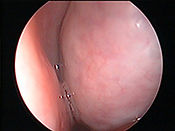18th Floor, Pearl Oriental House, No. 60 Stanley Street, Central, Hong Kong

Nose Services
Whenever nasal tumor or nasopharyngeal cancer is suspected, biopsy is a must. With the help of nasal endoscope, this can be safely carried out under topical anesthesia in a clinic setting.
Nasal Cautery
Dilated vessels over the nasal septum can cause troublesome nose bleeding.
Cauterization under local anesthesia with chemical, heat or Laser induces scarring over the septum, making recurrent bleeding less likely.
Nasoendoscopy
Using a small camera, the internal lining of the nose and nasopharynx is clearly magnified on a high resolution medical monitor. All nasal conditions can be immediately diagnosed and digitally recorded.
Endoscopic Polypectomy
Nasal Polyps lead to nasal blockage, postnasal drip, loss of smell and headache. Medical therapy can be tried initially. For patients with persistent symptoms, surgical removal is indicated.
Endoscope-assisted Turbinoplasty
Hypertrophied inferior turbinate can cause persistent nasal blockage despite medical therapy. The endoscope is used to visualize the surgery of turbinate reduction. The nose can be more thoroughly unblocked using this method.
Functional Endoscopic Sinus Surgery (FESS)
FESS restores functional drainage while preserving normal tissue of sinuses. Before nasal endoscope was introduced, the ENT surgeon worn a headlight and performed sinus surgery with naked eyes.
Nowadays, with endoscopes that can 'see' at different angles, finer equipment and advanced medical imaging, sinus surgery is safely performed under video-endoscopic control. This also minimizes the chance of injury to the eyes, blood vessels, nerve and brain.
Who needs the operation?
Those who have rhinosinusitis, nasal polyposis, tumors
Why having the operation?
-
Improve nasal symptoms such as obstruction, post-nasal dripping, facial pain, headache etc
-
Prevent complications of rhinosinusitis
-
Remove tumor
Septoplasty
Additional Septoplasty technique involves surgical removal of deviated bony and cartilaginous portions of nasal septum. Complete healing is expected within 2 weeks.
Who needs the operation?
People who have nasal obstruction with deviated nasal septum, Obstruction of sinus opening leading to sinusitis, Epistaxis and septal spur headache needs the surgery.
Why having the operation?
-
Reduce nasal obstruction
-
Reduce obstruction of sinus opening leading to sinusitis
-
Reduce epistaxis
-
Reduce septal spur headache
Turbinectomy
Overview:
Reduction of enlarged nasal mucosa and turbinate bone relieves nose block while preserving the normal nasal function of warming, humidifying and filtering. Best results are achieved when combined with Septoplasty for coexisting deviated nasal septum. Turbinectomy is the transnasal resection of inferior turbinates.
Who needs the operation?
Hypertrophic inferior turbinates causing nasal obstruction
Why having the operation?
Reduce nasal obstruction
There is chance of incomplete relief of nasal obstruction and recurrence.
Adenoidectomy (or Endoscope-assisted Suction Diathermy Adenoidectomy)
Heavy snoring in children is a warning sign for the dangerous Obstructive Sleep Apnoea Syndrome (OSAS). Removal of enlarged tonsils and adenoids provides dramatic relief.
Adenoid is a tissue located at nasopharynx.
Who needs the operation?
NOSE: nose block, snoring, sleep apnea, chronic or recurrent rhinosinusitis
EAR: otitis media with effusion, recurrent acute otitis media
Why having the surgery?
NOSE: Reduce airway obstruction, reduce snoring and sleep apnea, reduce chronic or recurrent rhinosinusitis
EAR: Relief otitis media with effusion, Reduce recurrent acute otitis media.
There is chance of incomplete relief of symptoms and recurrence.
Endoscope-assisted suction diathermy adenoidectomy is the latest technology which helps to minimize the risk of bleeding in this type of surgery.
Antral Washout
Under local anesthesia, the infected maxillary sinus is punctured with a strong needle and trocar. The sinus is then flushed with sterile fluid until clear of infective material. With the advent of more potent antibiotics and decongestant, this once popular procedure is rarely performed nowadays.

Before the Biopsy

Nasal Polyps

After the Biopsy

Nasal Polyps

Nasoendoscopy

After Endoscopic Polypectomy

After FESS


Nasal Polyps


Severe Deviated Nasal Septum

Before Surgery -Turbinate Hypertrophy

After Surgery

X ray-Child's Adenoid

Sinusitis

CT Scan-Normal Sinus

CT Scan-Sinusitis